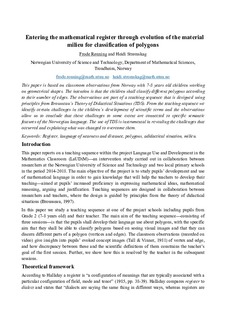| dc.contributor.author | Rønning, Frode | |
| dc.contributor.author | Strømskag, Heidi | |
| dc.date.accessioned | 2018-03-13T13:46:29Z | |
| dc.date.available | 2018-03-13T13:46:29Z | |
| dc.date.created | 2017-12-20T21:23:32Z | |
| dc.date.issued | 2017 | |
| dc.identifier.isbn | 978-1-873769-73-7 | |
| dc.identifier.uri | http://hdl.handle.net/11250/2490337 | |
| dc.description.abstract | This paper is based on classroom observations from Norway with 7-8 years old children working on geometrical shapes. The intention is that the children shall classify different polygons according to their number of edges. The observations are part of a teaching sequence that is designed using principles from Brousseau’s Theory of Didactical Situations (TDS). From the teaching sequence we identify certain challenges in the children’s development of scientific terms and the observations allow us to conclude that these challenges to some extent are connected to specific semantic features of the Norwegian language. The use of TDS is instrumental in revealing the challenges that occurred and explaining what was changed to overcome them. | nb_NO |
| dc.language.iso | eng | nb_NO |
| dc.publisher | European Society for Research in Mathematics Education | nb_NO |
| dc.relation.ispartof | Proceedings of the Tenth Congress of the European Society for Research in Mathematics Education (CERME10) | |
| dc.title | Entering the mathematical register through evolution of the material milieu for classification of polygons | nb_NO |
| dc.type | Chapter | nb_NO |
| dc.description.version | acceptedVersion | nb_NO |
| dc.identifier.cristin | 1530709 | |
| dc.description.localcode | Published by European Society for Research in Mathematics Education. Copyright the authors 2017. | nb_NO |
| cristin.unitcode | 194,63,15,0 | |
| cristin.unitname | Institutt for matematiske fag | |
| cristin.ispublished | true | |
| cristin.fulltext | postprint | |
